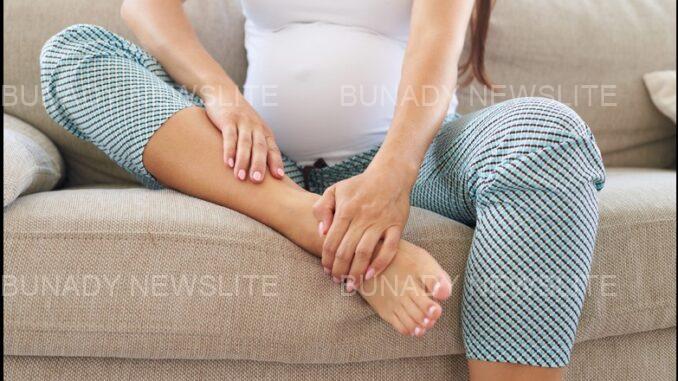

When it comes to pregnancy, there are so many physical changes a woman experiences. One of them is swollen feet. This usually happens due to increased fluid retention and pressure on the veins caused by the growing uterus.
END TIME IS NEAR INDEED: Watch The 3 Minutes Video Before It Deleted! See How Lady Rides On A Plastic Bottle To Satisfy Herself.
Swollen feet during pregnancy might be normal, but it is also uncomfortable and if you are experiencing this while pregnant, here are some home remedies that can help.
While more research is needed to determine whether these structural changes can be prevented, there are a few things you can do throughout your pregnancy to reduce swelling and feel more comfortable.
1. Wear compression socks
Wearing 15-20mmHG compression socks that end at your knee can help alleviate achiness. The socks gradually increase pressure in your legs and move some of the excess fluid back into your blood vessels and the rest of your body.
Avoid socks with a tight band at the top. The tightness might worsen swelling by blocking blood return. That can increase your risk of developing a blood clot – which is already five times higher during pregnancy. You don’t need to purchase medical-grade socks, but you can find a good pair of compression socks for $10-$20.
Compression socks also can prevent the formation of new varicose veins, which occur in 15% of pregnant women for the same reason that causes swelling. The risk doubles after your first pregnancy and is four times higher in women over 35. These veins start out as little bumps under your skin; the socks squeeze them just enough to prevent backward blood flow and bulging. Existing varicose veins aren’t likely to shrink, but compression socks can reduce the pain and discomfort they cause.
END TIME IS NEAR INDEED: Watch The 3 Minutes Video Before It Deleted! See How Lady Rides On A Plastic Bottle To Satisfy Herself.
2. Rest efficiently
You can easily improve blood circulation during downtime and sleep:
Elevate your legs above heart level while reading, watching TV, or doing other seated activities. The simple change in body position decreases pressure on your veins, which no longer have to work against gravity to send blood to your heart. Use cushions for comfort and elevate in 15- to 20-minute intervals a few times a day.
Sleep on your left side. While you can safely sleep on either side during pregnancy, the left side is often recommended to avoid putting pressure on the inferior vena cava, a large vein that carries blood from your lower extremities to your heart.
3. Get your feet wet
Immersing your feet and ankles in cool water for 20 minutes a few times a week can minimize swelling, whether you use a pool, bathtub, or even a large bowl. Bonus: It’s also a great way to deal with the Texas heat if you’re pregnant during the summer.
Be sure the water temperature is moderate and not ice cold. Cooler temperatures cause the smaller blood vessels close to your skin to constrict, which reduces blood flow to and swelling within the affected area. Water that is too cold can have the opposite effect. Whether you stand and sway or sit and dangle your feet, water therapy is a great way to relieve stress and pain.
4. Invest in supportive shoes that fit.
Unsupportive and uncomfortable shoes can cause even more leg and foot pain, plus backaches. Even if your feet return to their pre-pregnancy size, you’ll feel more comfortable in shoes that fit your feet and support your additional body weight. The American College of Obstetricians and Gynecologists recommends wearing shoes that:
Have a low heel but are not flat
Provide good arch support, such as athletic shoes
Many patients prefer shoes that have mesh, which allow their feet to breathe, and can easily slip on and off to limit bending over while pregnant. More shoe brands are merging comfort and style, so even the most fashionable patients will have no problem finding footwear they feel good about wearing.
5. Visit a podiatrist or pedicurist.
Another reason to wear shoes that fit: Stress from tight shoes can cause ingrown toenails, and so can infrequent nail trimming. In the first two trimesters you probably won’t have any difficulty trimming your toenails. But once you reach the third trimester, it might get more challenging.
END TIME IS NEAR INDEED: Watch The 3 Minutes Video Before It Deleted! See How Lady Rides On A Plastic Bottle To Satisfy Herself.


